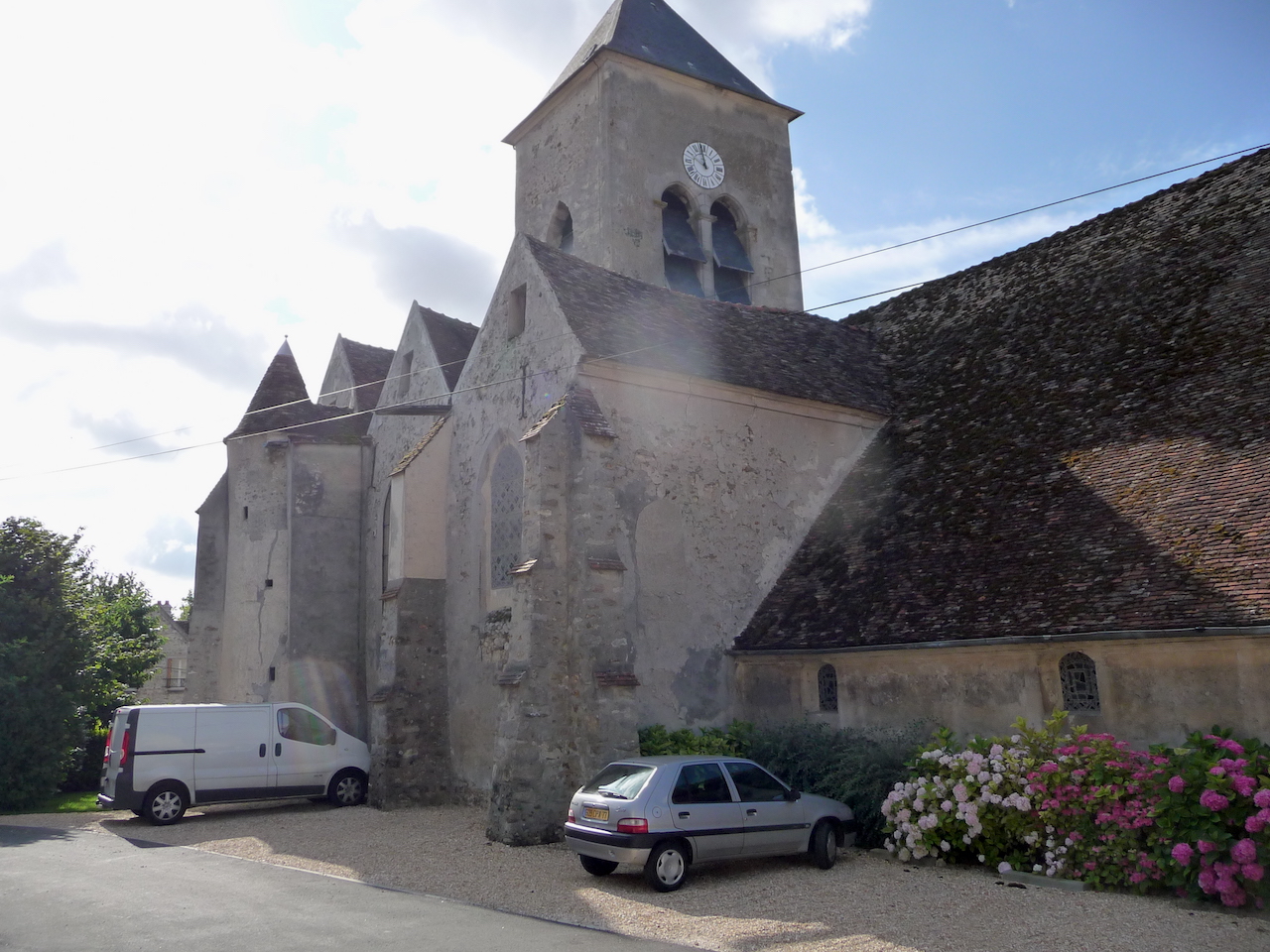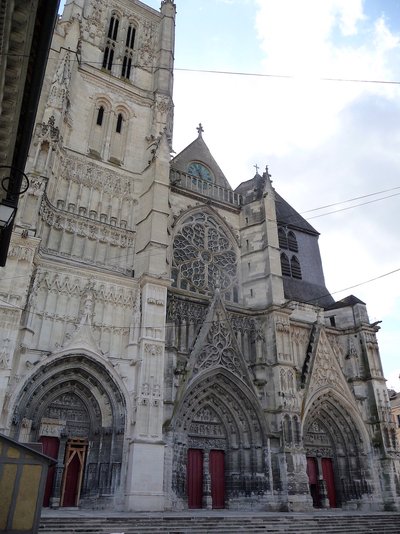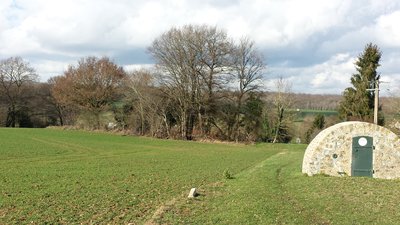Meaux to Ussy-sur-Marne

Île-de-France
14. Meaux to Ussy-sur-Marne
Medium
5h30
23,3km
+353m
-352m
Step
Embed this item to access it offline
As soon as you leave Meaux, nature offers itself to you. Take the time to discover the heritage of Nanteuil-les-Meaux and Montceaux-les-Meaux, a village of character. Admire the banks of the Marne, a favourite place for painters. Let yourself be told the story of Colomban and his companions in Ussy-sur-Marne.
7 points of interest

Façade la cathédrale Saint-Étienne de Meaux - Association Colomban en Brie TouristSaint-Étienne Cathedral in Meaux
Saint Stephen's Cathedral surprises with its unfinished facade: above the three portals, the upper floor of the high windows leads the eyes to only one tower, in flamboyant style, on the northern side. Despite its 350 years of construction, it is relatively harmonious and its short length (barely 2/3 of that of Paris) is compensated by an impressive rise in all its five ships. It is home to the tomb of Bishop Jacques-Bénigne Bossuet, the "eagle" of Meaux in the 17th century.
More information: Wilkipédia
L’église Saint-Jean-Baptiste et Saint-Fiacre - Saint Colomban en Brie St ColumbanSaint-Fiacre
Saint Fiacre is an Irish monk who lived in the 7th century and is attested in writings from the 11th century. He was welcomed by Saint Faron, a monk in the Columbian tradition who had founded a monastery in Meaux. He settled on the land of Le Breuil, now the village of Saint-Fiacre, to live as a hermit. The land of the hermitage was fertile and the monk fed all the poor with vegetables and fruit, later becoming the patron saint of gardeners. Due to the influx of pilgrims, the hermitage became a priory attached to the abbey of Saint-Faron de Meaux. It is still celebrated every 30 August by brotherhoods of gardeners in Europe and is honoured in Quebec. In 1683 King Louis XIV, accompanied by Maria Theresa, made a pilgrimage to Saint-Fiacre.
In the 13th century, the body of the Saint was placed in a shrine, creating a very flourishing pilgrimage until the Revolution. He was invoked for diseases of the rectum, which are called the Saint-Fiacre disease. This pilgrimage route has been reactivated and you can discover it on the information boards in front of the church of Saint-Jean-Baptiste and Saint-Fiacre.
In Paris, the Saint-Fiacre hotel, which had become a carriage factory, gave a new name to the carriages: the fiacre.
Translated with www.DeepL.com/Translator (free version)
Ancienne entrée du château de Montceaux-lès-Meaux devenue un parc ouvert au public - Association Colomban en Brie HistoricalRoyal Castle of Montceaux-lès-Meaux
Only the imposing ruins of the royal castle of Montceaux-lès-Meaux remain. The latter was yet in the Renaissance a major place of power and knew many intrigues in the fifteenth and sixteenth century.
In 1498 the castle of Montceaux was a modest manor belonging to Michel Saligot, lord of Montceaux and Montretout. It was sold in 1555 to Henri II who offered it to his mother, Catherine de Medici, who stayed there occasionally and undertook restoration and embellishment work under the direction of the architect Philibert Delorme.
In 1595, King Henri IV offered it to his favourite, Gabrielle d'Estrées. It was from this castle that the reconciliation between Henri IV and the Duke of Mayenne, head of the Catholic League that put an end to the Wars of Religion, took place. On the death of Gabrielle d'Estrées, the king gave the domain to the queen, Marie de Medici. Works are then started under the direction of the architect Salomon de Brosse. The castle was demolished during the Revolution. Only the chapel and the buildings of the forecourt transformed into a bourgeois house and the eastern part of the castle became a farmhouse.
The Royal Castle of Montceaux les Meaux, classified as a Historic Monument for its park and buildings, is a high place in the history of France.
Un des nombreux regards visibles sur la Via Columbani. - Association Colomban en Brie PanoramicDhuys Aquädukt
During your stage you will walk on the Dhuys aqueduct, it was already the case during the previous stage.
In the 19th century hygiene became a concern for the city of Paris and the waters of the Seine were polluted, as well as the canals crossing the capital. The need for drinking water was urgent, and the capture of more distant sources had to be considered. The city asked the engineer Belgrand, then in charge of the Water and Forestry Department, to divert the waters of the Dhuys from Pargny-la-Dhuys in the Aisne to bring them to Paris by building an aqueduct. The aqueduct is 130 kilometres long with a difference in altitude of 20 metres. It was begun in 1863 and completed two years later. To cross the obstacles - rivers and valleys - the aqueduct uses siphons using the principle of communicating vessels which was already well mastered in Roman times. The aqueduct supplies 20,000 m3 of water per day to the city of Paris.
Milestones, siphons and manholes trace its course.
As the canal crosses very loose ground, collapses are frequent and lead to major restoration work. In the 1990s, the city of Paris abandoned this source of drinking water in favour of the treatment of water from the Seine and the Marne. The aqueduct runs through the new conurbation, Val d'Europe, and in 2016 the commune will buy almost the entire canal from the city of Paris for its local use.
Église Saint-Jean-Baptiste à Saint-Jean-les-Deux Jumeaux - Wikipédia Thor 4 TouristChurch Saint-Jean Baptiste de Saint-Jean-les-Deux-Jumeaux
A first church is mentioned in the 13th century, it seems that the pillars of the choir date from this period.
Works have been carried out over the centuries. The western façade is preceded by a masonry porch. It is surmounted by an oculus and then by a small semicircular bay. It is framed by high buttresses.
The church has beautiful 17th century wainscotings. They were restored in the 20th century.
Vue du bas-côté nord de l’église Saint-Authaire - Association Colomban en Brie St ColumbanÉChurch Saint-Authaire à Ussy-sur-Marne
In the life of Saint Colomban, written around 640, the monk Jonas de Bobbio indicates that Colomban and his companions were welcomed by the family of Authaire, an aristocrat at the court of Austrasia. The domus where this servant of Théodebert (or Thibert) king of Austrasia and friend of Colomban, resided, would be located in the commune of Ussy-sur-Marne.
If archaeological excavations do not allow us to date the church of Ussy-sur-Marne with certainty, it is very likely that Authaire, a fervent Christian, was buried in a consecrated place near his residence.
The hagiograph of Saint Colomban tells us that he blessed two children of Authaire, Dadon who became bishop of Rouen under the name of Saint-Ouen and Adon founder of the monastery of Jouarre.
In the church, a 19th century stained glass window reminds us of this meeting. This stained glass window was restored in 2013 by the St Authaire Parish Association with the help of the Town Hall.
The foundations of the church allow us to date it from the 9th century, during the following centuries several extensions were made. It is composed of a nave with a north aisle that extends to a chapel dedicated to the Virgin Mary. The nave and the north aisle are separated by a row of large pointed arches supported by quadrangular piers. The nave is carpentry. The choir is vaulted.
The church is listed as a Historic Monument for its 11th and 12th century nave, and the glass canopies of its 16th century Chapel of the Virgin.
L’article publié par l’association pour la sauvegarde d’Ussy - Association Colomban en Brie CulturalSamuel Beckett, a very discreet resident at Ussy-sur-Marne
The famous Irish writer, Nobel Prize winner for Literature, wanting to leave the hustle and bustle of the Parisian salons had bought a small house on the heights of Ussy-sur-Marne. He liked to say that the hilly landscapes of the Brie region reminded him of his native Ireland.
This small second home is privately owned.
Discover this episode of the writer's life on the website of the association pour la sauvegarde d'Ussy
Description
Departure from the esplanade of Meaux cathedral. Walk along the cathedral on your left, third street on the right, rue de la Cordonnerie, take the Pont du Marché to cross the Marne.
- Turn left immediately, walk along the Marne (red and white markings) and pass under the Pont Neuf, then under the Pont Foch.
- Turn right onto the Quai Charles Deboeuf and go up the Route D360, on the left take the bridge to cross the canal and go down immediately on the left. On the banks of the Marne, turn right onto Quai du Maréchal Mortier. Turn right again and drive along lock n°12. Turn left onto the D360 and cross the lock.
- Go down to the left, Chemin Bas. Immediately turn left to join the Marne. Turn right to find the Chemin Bas and left to follow the Marne with a dirt track
- At the crossroads, turn right into Rue de Marne. First crossroads on the left, Chemin du Vieux Noix. At the fork in the road, turn right into Rue de la Lampe.
- On the right in front of the church, second street on the left, Rue Gambetta. First alley on the left which continues into a path (Sente de la Petite Arche). Stay on your left, rue Galliéni, first left, rue Raymond Marchand, cross rue Georges Dagron and first right, rue Raymond Marchand then first left rue du petit Val
- Stay on your right, Chemin du petit val, first dirt track on the right, ruelle du Pont, enter the wood (red and white beacon, ruelle du Pont, first track on the right, chemin rural de Saint-Fiacre, enter Boutigny along the housing estate, on the left chemin de l'aqueduc de la Duys
- Turn right at the crossroads with the road from Flublaines to Saint-Fiacre, rue de Meaux, left rue Saint-Jean, left chemin de la vignette, twice right to join de l'Aqueduc de la Duys
- Cross the route de Fublaines then turn right following the median of the Aqueduc de la Duys. Cross the D33 straight on, follow the path of the Aqueduc de la Dhuys, right at the crossroads with rue du Vieux Pavé, left at the roundabout, rue du Château, right pass the church on your left cross the D19, rue des palais, chemin de Montebise, second street on the left, D19a rue Saint-Jean
- Leave the D19a at the right-hand bend, go straight on, cross the chemin de l'Aqueduc de la Duys
- Turn right then left to enter Saint-Jean-les-Deux-Jumeaux, rue Alfred de Musset, go round the church on your right, cross the car park on your right then left across the D 603 rue Raymond Poincaré, take the D53a rue Maréchal Foch
- On the right before the bridge over the Marne, go along the Marne, pass under the autoroute de l'Est, take the bridge on the left, to cross the Marne, first street on the left you arrive at the church of Ussy-sur-Marne.
- Departure : Saint-Etienne's Cathedral, Place Charles de Gaulle, 77100, Meaux
- Arrival : Church Saint-Authaire , 3 rue de Changis , 77260 Ussy-sur-Marne
- Towns crossed : Île-de-France
Altimetric profile
Transport
Report a problem or an error
If you have found an error on this page or if you have noticed any problems during your hike, please report them to us here:
Close by8
- Accommodation
Accommodation
Chambres chez Annie & Alain à Nanteuil-lès-Meaux
Die Unterkunft in diesem Gästezimmer teilt sich einen Aufenthaltsbereich mit kostenlosem Tee und Kaffee. Das Gemeinschaftsbad ist mit einer Dusche und einem Fön ausgestattet. Die Zimmer sind mit einem Flachbildfernseher ausgestattet und bieten einen Blick auf den Innenhof.








